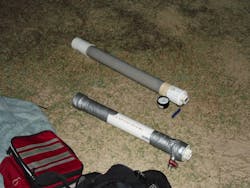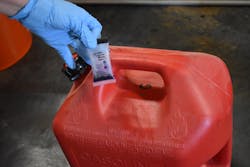Clandestine Drug Labs: A Tactical and Practical Approach
Clandestine drug laboratories are a witch’s brew of hazards for firefighters. They can contain as many as eight of the nine hazard classes. (Radiation generally isn’t used nor produced as a byproduct in the manufacture of illegal drugs.)
Furthermore, these drug manufacturing facilities are operated by individuals who are involved in illegal activities. Odds are the bad guys aren’t going to welcome you with open arms. Every response to clandestine drug labs requires a tactical, hazmat, head-on-a-swivel mindset.
Clandestine drug labs can be found in almost any jurisdiction. They range from sophisticated operations that have commercial-grade laboratory equipment to “one-pots in the back seat of a vehicle.” These labs are used to produce, process, convert or mill a variety of illegal drugs. These drugs include methamphetamine, fentanyl, butane hash oil, N,N-Dimethyltryptamine (DMT), ecstasy (MDMA), GHB (gamma-hydroxybutyrate) and LSD. Because of space constraints, this article only addresses firefighter response to labs that are used to make methamphetamine.
There are four methods of producing methamphetamine—P2P, red phosphorus, Nazi/Birch reduction and one-pot. Three of these methods are distinctly different. (The Nazi/Birch reduction and one-pot methods both utilize ammonia as a reducing agent.) Each method has multiple hazards that are associated with it.
The P2P, or Amalgam or biker lab, method, uses phenyl-2-propanone (P2P) and methylamine as precursors. The primary hazards that are associated with this method are flammability, CNS toxicity, skin absorption, and lead- and mercury-contaminated waste. That said, the P2P method has fallen out of favor with most meth “cooks” because of: the limited availability of the precursors since they became regulated; the length of time for production; and the low yield and concentration of the finished product.
The red phosphorus, or Red P, method uses hydrogen iodide and red phosphorus to reduce ephedrine or pseudoephedrine to methamphetamine. Hydrogen iodide is created using iodine crystals. Iodine is a particularly nasty chemical. It is a strong oxidizer and has an immediately dangerous to life and health (IDLH) value of 2 ppm. The Red P method can result in methamphetamine that has a purity of 95 percent. Because of the somewhat complicated process and of the difficulty obtaining the needed chemicals, cooks and users prefer to utilize an ammonia-based method for manufacturing methamphetamine. The primary hazards that are associated with this method are oxidizers, inhalation and absorbent toxicants, production of white phosphorus, production of phosphine gas and corrosive vapors.
The Nazi/Birch reduction method, which relies on a plentiful supply of anhydrous ammonia, became popular with illegal methamphetamine drug labs in the early 1990s. It reacts ephedrine or pseudoephedrine with liquid anhydrous ammonia and an alkali metal, such as sodium or lithium. The reaction is allowed to stand until the ammonia evaporates. However, Birch reduction is dangerous because the alkali metal and the ammonia are extremely reactive, and the temperature of liquid ammonia makes it susceptible to explosive boiling when reactants are added.
Birch reduction labs have been primarily in rural communities. Liquid anhydrous ammonia readily was available in farming regions and stored at farm supply centers with little or no security.
The primary hazards that are associated with the birch reduction method are flammability, overpressurization, inhalation toxicant, corrosivity and water reactivity.
In the one-pot method, which also is known as shake and bake, pseudoephedrine is reduced to methamphetamine using ammonium nitrate, lithium metal, sodium hydroxide, hydrochloric acid and a solvent. This method has become popular with addicts and is the most common type of clandestine drug lab that we see. Whereas restrictions have made it difficult to get the amount of pseudoephedrine that’s needed for the Red P and Nazi/Birch reduction methods, the chemicals that are necessary for the one-pot method can be obtained easily, even at a Walmart store.
Because these cooks tend to use 24–32-oz. plastic bottles, they create a pressurized atmosphere in a nonpressurized container. The one-pot method requires the container to be “burped” during the cooking process. Most meth cooks who use a plastic bottle simply loosen the cap to relieve pressure. That said, when it comes down to it, this is a trial-and-error process that has a significant likelihood of overpressurization occurring. Although plastic bottles/containers aren’t intended to be improvised explosive devices, that is in fact what they end up being.
The primary hazards that are associated with the one-pot method of illegally producing meth are heat generation, production of flammable vapors, overpressurization of containers, corrosive liquids and vapors, and fire from water-reactive metals.
Clandestine labs can be found in almost any location imaginable. Homes, storage facilities, motel rooms and vehicles are popular sites for them. Often, clandestine drug labs are discovered by responders who are at the premises for a medical call.
Firefighters and law enforcement should be alert for items and materials that don’t make sense or seem out of place. These items can include pseudoephedrine packs, lithium batteries and their packaging, cold packs, solvents (Coleman fuel is the favorite among most cooks), drain cleaner, Pyrex glassware, coffee grinders, coffee filters and plastic bottles, including ones that have tubing that’s attached at the top or that contain an off-white residue.
If any plastic bottles that you encounter show signs of increased pressure or have an active process on going, don’t handle them. The bottles are at risk for overpressurization and rupture.
The response
Methamphetamine labs response is multilayered. The labs are both a crime scene and a hazmat scene. Remember, it’s possible that clandestine drug labs can contain eight of the nine hazard classes, and those who operate them are criminals.
Obviously, these facts necessitate that both law enforcement and fire department presence. Establishing relationships between agencies prior to the response is the key to success for everyone involved.
Several years ago, there was an uptick in methamphetamine labs in Nashville, TN. The majority of these were one-pot labs. Realizing the need for a dual response, the fire and police departments of Nashville joined forces. They trained together and aligned equipment, PPE and protocols. The result was a smooth and coordinated response to methamphetamine labs.
(A normal SWAT response isn’t appropriate for these situations. Because of the hazardous, potentially flammable and toxic environment that will be encountered, PPE needs are specific. SWAT members who lack a hazmat mindset developed via dual-agency training are at exceptional risk.)
Because of the inherent risk from criminal activity, the scene first must be secured by law enforcement: Fire department personnel never should enter a crime scene that’s unsecured.
Once the scene is secured, air monitoring becomes the priority. Monitoring principles don’t change: Radiation, PH, flammability and oxygen concentration are the basics. This is accomplished using radiation-detection instruments, PH paper and a multigas meter that has photo-ionization-detector capability. (Author’s note: In the monitoring process for any hazmat call, radiation is done first. Even though firefighters might know that they are about to encounter a meth lab—and radiation generally isn’t used nor produced as a byproduct in the manufacture of illegal drugs of whatever sort—the first entry is considered an unknown environment until monitoring confirms what is and isn’t present.)
As firefighters, we generally aren’t trained in crime-scene procedures. How do we accomplish our mission at a clandestine drug lab without contaminating or disrupting the crime scene? Again, the most practical solution is the dual-response approach of police officers and firefighters training together—specifically, hazmat team members and narcotics officers.
Entry into the Hot Zone is made by a firefighter and a police officer who have similar training and an appropriate skill set. This allows for proper monitoring and hazard recognition while maintaining the integrity of the crime scene.
PPE
What is the proper PPE for a clandestine drug lab response? The level and type of PPE should be matched to the hazard that you might encounter. Flammability, corrosivity, oxygen deficiency and toxicity are some of the hazards that are encountered by responders in a clandestine lab.
What level and types of PPE offer you the optimum protection? For many of these responses, Level B with thermal protection is the correct choice. The traditional structural firefighting ensemble provides extremely limited chemical protection. Chemical protective clothing, such as LION’s MT94 or a Blauer Multi-Threat ensemble that’s partnered with an SCBA, provide the needed level of protection.
You must not forget decontamination. Clandestine drug labs are by their very nature toxic dump sites. Everyone who enters such a site must be decontaminated. This includes the cooks and any occupants of the structure. You can’t allow them to remain in their clothing. Once outside of the structure, their clothing might continue to off-gas. Until cooks/occupants are decontaminated, anywhere that they go is a Hot Zone. An easy way for responders to address this is to use Tyvek suits. The occupants remove their contaminated clothing and are sent through a decontamination corridor. Once this process is completed, they are given a Tyvek suit to wear.
How do we accomplish decontamination? Like any other hazardous materials response, it’s contaminant-specific. You should utilize the most appropriate method(s) applicable. This could include vaporization, the use of surfactants, the use of neutralizing agents and specific decontamination solutions. Dahlgren Decon and Decon7 are two examples of decontamination solutions that might be of benefit during a clandestine drug lab response.
Remember, have some form of decontamination set up prior to entry. This could be as in-depth as a three-station contamination-reduction corridor or as simple as red line pulled from an engine company. Also, you are responsible for any waste that’s generated because of decontamination procedures. You must have a plan for containing wastewater and any potential runoff as well as for containment of contaminated clothing.
Cooperation is key
Clandestine drug labs pose many challenges for firefighters. They are extremely dangerous and can be the home of extremely dangerous people. These labs require the response of multiple agencies that work hand in hand.
On top of everything, the cost that’s associated with these responses can tax the budgets of fire departments. The key to fire department success is to establish relationships with local, state and federal law enforcement partners.
Conversion Labs
High-quality methamphetamine is being imported from Mexico. Drug cartels produce this meth in a liquid state, which makes it easier to smuggle across the border. Conversion labs convert the liquid meth to a crystalline substance. To do so, the liquid meth is heated to evaporate the liquid. Often, the underlying substance is a flammable solvent. Obviously, heat and a flammable don’t play well together.
About the Author

Scott Burgess
Scott Burgess recently retired as a captain/paramedic with the Nashville, TN, Fire Department and a Clandestine Drug Lab Response instructor. Additionally, he is a Hazardous Materials instructor for the Center for Domestic Preparedness in Anniston, AL.


